Promoting Diversity and Inclusion in the Legal Profession: An Analysis
VerifiedAdded on 2019/12/03
|8
|2558
|28
Essay
AI Summary
This essay provides a comprehensive analysis of diversity within the legal profession, focusing on the barriers faced by under-represented groups such as ethnic minorities and women. It highlights financial obstacles, including the high cost of legal education and training, as well as cultural barriers like networking biases and perceived rigidity. The essay explores the impact of these factors on career progression and the under-representation of certain groups in the legal field. It also examines the efforts of law schools and firms to promote diversity through initiatives like CV-blind recruitment and scholarship programs. The analysis considers the role of government and legal bodies in fostering inclusion, including the implementation of apprentice programs and the provision of guidelines to prevent discrimination. The essay concludes with recommendations for enhancing flexibility in legal education and promoting fair recruitment practices to create a more equitable and diverse legal profession.

Legal profession and legal
services
1
services
1
Paraphrase This Document
Need a fresh take? Get an instant paraphrase of this document with our AI Paraphraser
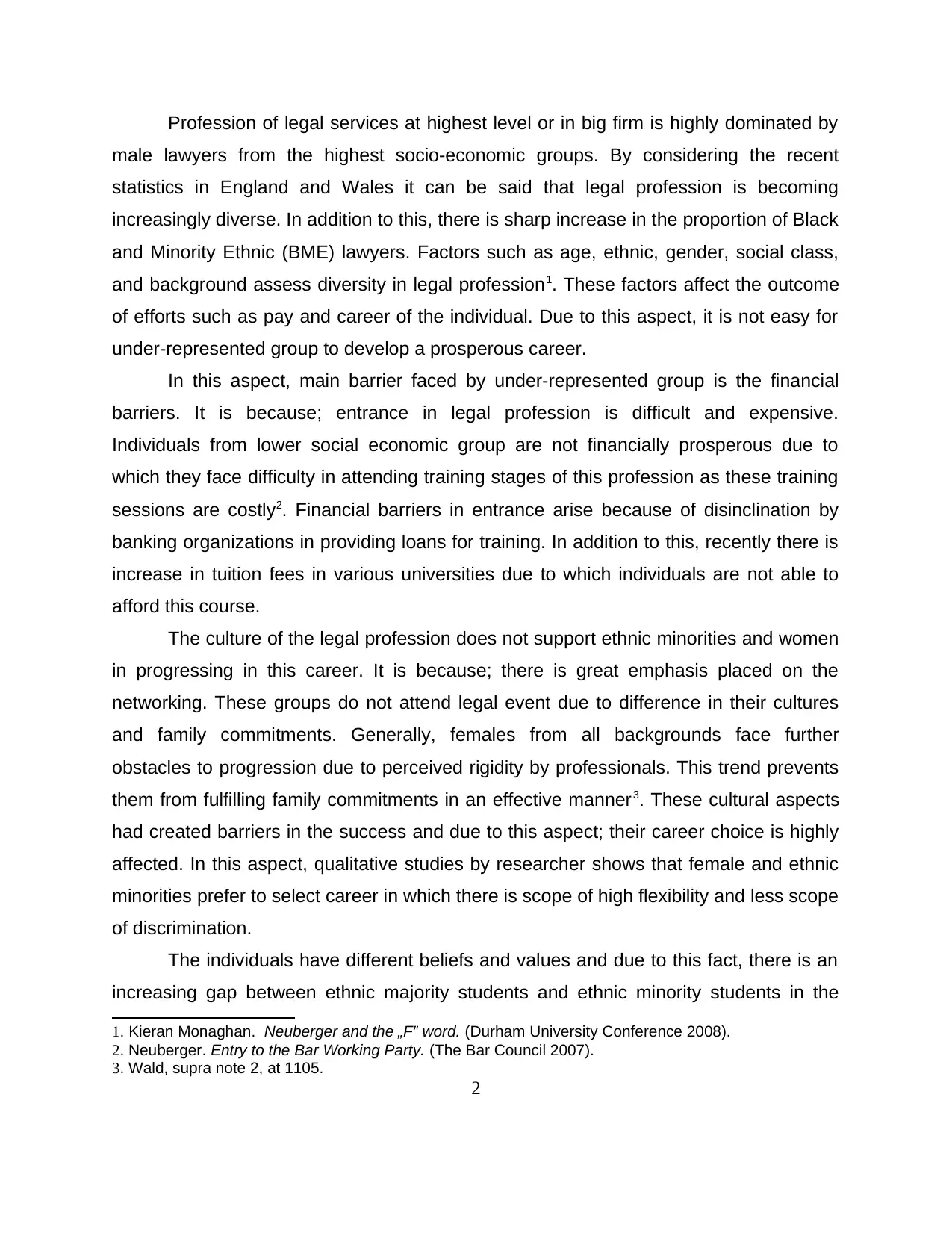
Profession of legal services at highest level or in big firm is highly dominated by
male lawyers from the highest socio-economic groups. By considering the recent
statistics in England and Wales it can be said that legal profession is becoming
increasingly diverse. In addition to this, there is sharp increase in the proportion of Black
and Minority Ethnic (BME) lawyers. Factors such as age, ethnic, gender, social class,
and background assess diversity in legal profession1. These factors affect the outcome
of efforts such as pay and career of the individual. Due to this aspect, it is not easy for
under-represented group to develop a prosperous career.
In this aspect, main barrier faced by under-represented group is the financial
barriers. It is because; entrance in legal profession is difficult and expensive.
Individuals from lower social economic group are not financially prosperous due to
which they face difficulty in attending training stages of this profession as these training
sessions are costly2. Financial barriers in entrance arise because of disinclination by
banking organizations in providing loans for training. In addition to this, recently there is
increase in tuition fees in various universities due to which individuals are not able to
afford this course.
The culture of the legal profession does not support ethnic minorities and women
in progressing in this career. It is because; there is great emphasis placed on the
networking. These groups do not attend legal event due to difference in their cultures
and family commitments. Generally, females from all backgrounds face further
obstacles to progression due to perceived rigidity by professionals. This trend prevents
them from fulfilling family commitments in an effective manner3. These cultural aspects
had created barriers in the success and due to this aspect; their career choice is highly
affected. In this aspect, qualitative studies by researcher shows that female and ethnic
minorities prefer to select career in which there is scope of high flexibility and less scope
of discrimination.
The individuals have different beliefs and values and due to this fact, there is an
increasing gap between ethnic majority students and ethnic minority students in the
1. Kieran Monaghan. Neuberger and the „F‟ word. (Durham University Conference 2008).
2. Neuberger. Entry to the Bar Working Party. (The Bar Council 2007).
3. Wald, supra note 2, at 1105.
2
male lawyers from the highest socio-economic groups. By considering the recent
statistics in England and Wales it can be said that legal profession is becoming
increasingly diverse. In addition to this, there is sharp increase in the proportion of Black
and Minority Ethnic (BME) lawyers. Factors such as age, ethnic, gender, social class,
and background assess diversity in legal profession1. These factors affect the outcome
of efforts such as pay and career of the individual. Due to this aspect, it is not easy for
under-represented group to develop a prosperous career.
In this aspect, main barrier faced by under-represented group is the financial
barriers. It is because; entrance in legal profession is difficult and expensive.
Individuals from lower social economic group are not financially prosperous due to
which they face difficulty in attending training stages of this profession as these training
sessions are costly2. Financial barriers in entrance arise because of disinclination by
banking organizations in providing loans for training. In addition to this, recently there is
increase in tuition fees in various universities due to which individuals are not able to
afford this course.
The culture of the legal profession does not support ethnic minorities and women
in progressing in this career. It is because; there is great emphasis placed on the
networking. These groups do not attend legal event due to difference in their cultures
and family commitments. Generally, females from all backgrounds face further
obstacles to progression due to perceived rigidity by professionals. This trend prevents
them from fulfilling family commitments in an effective manner3. These cultural aspects
had created barriers in the success and due to this aspect; their career choice is highly
affected. In this aspect, qualitative studies by researcher shows that female and ethnic
minorities prefer to select career in which there is scope of high flexibility and less scope
of discrimination.
The individuals have different beliefs and values and due to this fact, there is an
increasing gap between ethnic majority students and ethnic minority students in the
1. Kieran Monaghan. Neuberger and the „F‟ word. (Durham University Conference 2008).
2. Neuberger. Entry to the Bar Working Party. (The Bar Council 2007).
3. Wald, supra note 2, at 1105.
2
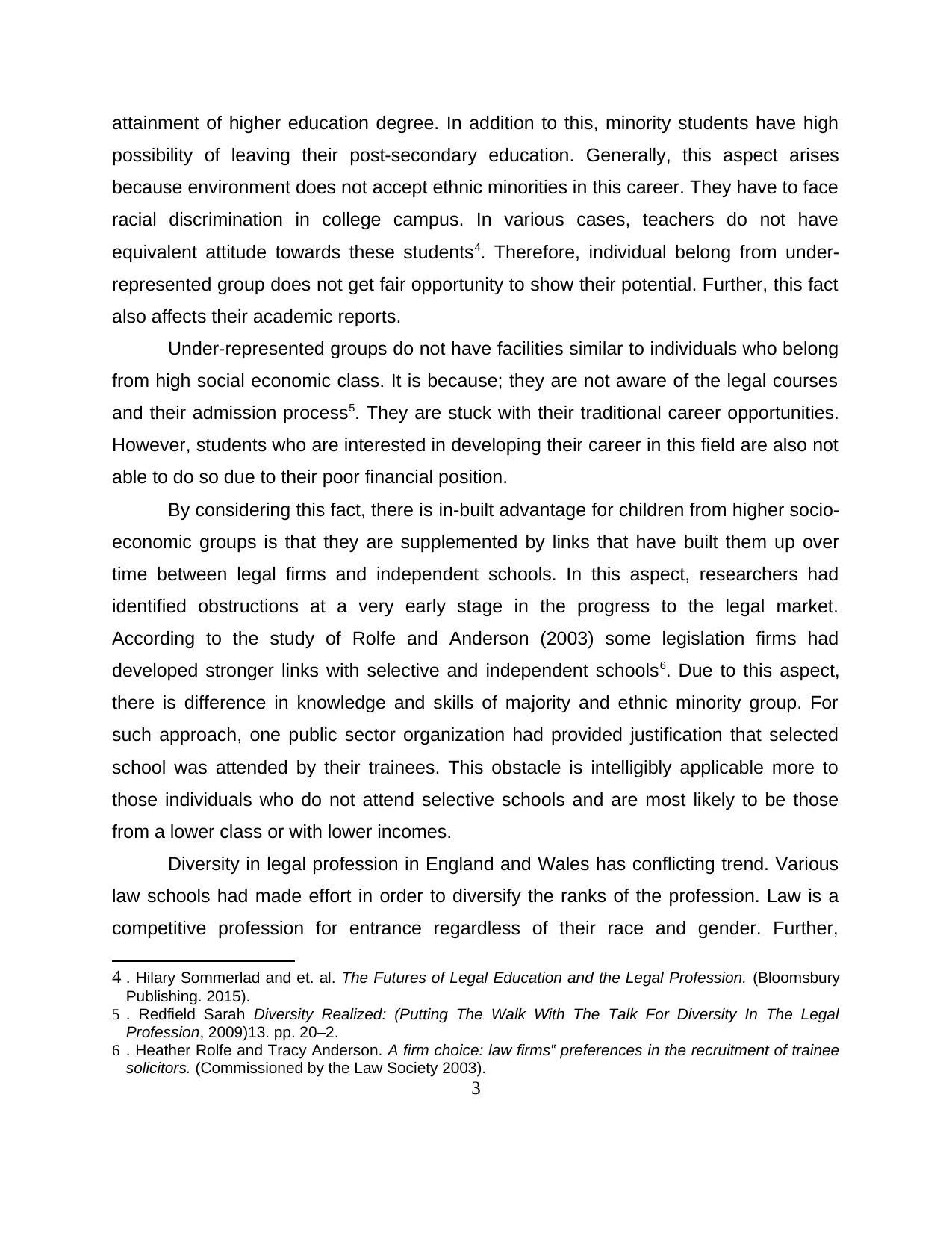
attainment of higher education degree. In addition to this, minority students have high
possibility of leaving their post-secondary education. Generally, this aspect arises
because environment does not accept ethnic minorities in this career. They have to face
racial discrimination in college campus. In various cases, teachers do not have
equivalent attitude towards these students4. Therefore, individual belong from under-
represented group does not get fair opportunity to show their potential. Further, this fact
also affects their academic reports.
Under-represented groups do not have facilities similar to individuals who belong
from high social economic class. It is because; they are not aware of the legal courses
and their admission process5. They are stuck with their traditional career opportunities.
However, students who are interested in developing their career in this field are also not
able to do so due to their poor financial position.
By considering this fact, there is in-built advantage for children from higher socio-
economic groups is that they are supplemented by links that have built them up over
time between legal firms and independent schools. In this aspect, researchers had
identified obstructions at a very early stage in the progress to the legal market.
According to the study of Rolfe and Anderson (2003) some legislation firms had
developed stronger links with selective and independent schools6. Due to this aspect,
there is difference in knowledge and skills of majority and ethnic minority group. For
such approach, one public sector organization had provided justification that selected
school was attended by their trainees. This obstacle is intelligibly applicable more to
those individuals who do not attend selective schools and are most likely to be those
from a lower class or with lower incomes.
Diversity in legal profession in England and Wales has conflicting trend. Various
law schools had made effort in order to diversify the ranks of the profession. Law is a
competitive profession for entrance regardless of their race and gender. Further,
4 . Hilary Sommerlad and et. al. The Futures of Legal Education and the Legal Profession. (Bloomsbury
Publishing. 2015).
5 . Redfield Sarah Diversity Realized: (Putting The Walk With The Talk For Diversity In The Legal
Profession, 2009)13. pp. 20–2.
6 . Heather Rolfe and Tracy Anderson. A firm choice: law firms‟ preferences in the recruitment of trainee
solicitors. (Commissioned by the Law Society 2003).
3
possibility of leaving their post-secondary education. Generally, this aspect arises
because environment does not accept ethnic minorities in this career. They have to face
racial discrimination in college campus. In various cases, teachers do not have
equivalent attitude towards these students4. Therefore, individual belong from under-
represented group does not get fair opportunity to show their potential. Further, this fact
also affects their academic reports.
Under-represented groups do not have facilities similar to individuals who belong
from high social economic class. It is because; they are not aware of the legal courses
and their admission process5. They are stuck with their traditional career opportunities.
However, students who are interested in developing their career in this field are also not
able to do so due to their poor financial position.
By considering this fact, there is in-built advantage for children from higher socio-
economic groups is that they are supplemented by links that have built them up over
time between legal firms and independent schools. In this aspect, researchers had
identified obstructions at a very early stage in the progress to the legal market.
According to the study of Rolfe and Anderson (2003) some legislation firms had
developed stronger links with selective and independent schools6. Due to this aspect,
there is difference in knowledge and skills of majority and ethnic minority group. For
such approach, one public sector organization had provided justification that selected
school was attended by their trainees. This obstacle is intelligibly applicable more to
those individuals who do not attend selective schools and are most likely to be those
from a lower class or with lower incomes.
Diversity in legal profession in England and Wales has conflicting trend. Various
law schools had made effort in order to diversify the ranks of the profession. Law is a
competitive profession for entrance regardless of their race and gender. Further,
4 . Hilary Sommerlad and et. al. The Futures of Legal Education and the Legal Profession. (Bloomsbury
Publishing. 2015).
5 . Redfield Sarah Diversity Realized: (Putting The Walk With The Talk For Diversity In The Legal
Profession, 2009)13. pp. 20–2.
6 . Heather Rolfe and Tracy Anderson. A firm choice: law firms‟ preferences in the recruitment of trainee
solicitors. (Commissioned by the Law Society 2003).
3
⊘ This is a preview!⊘
Do you want full access?
Subscribe today to unlock all pages.

Trusted by 1+ million students worldwide
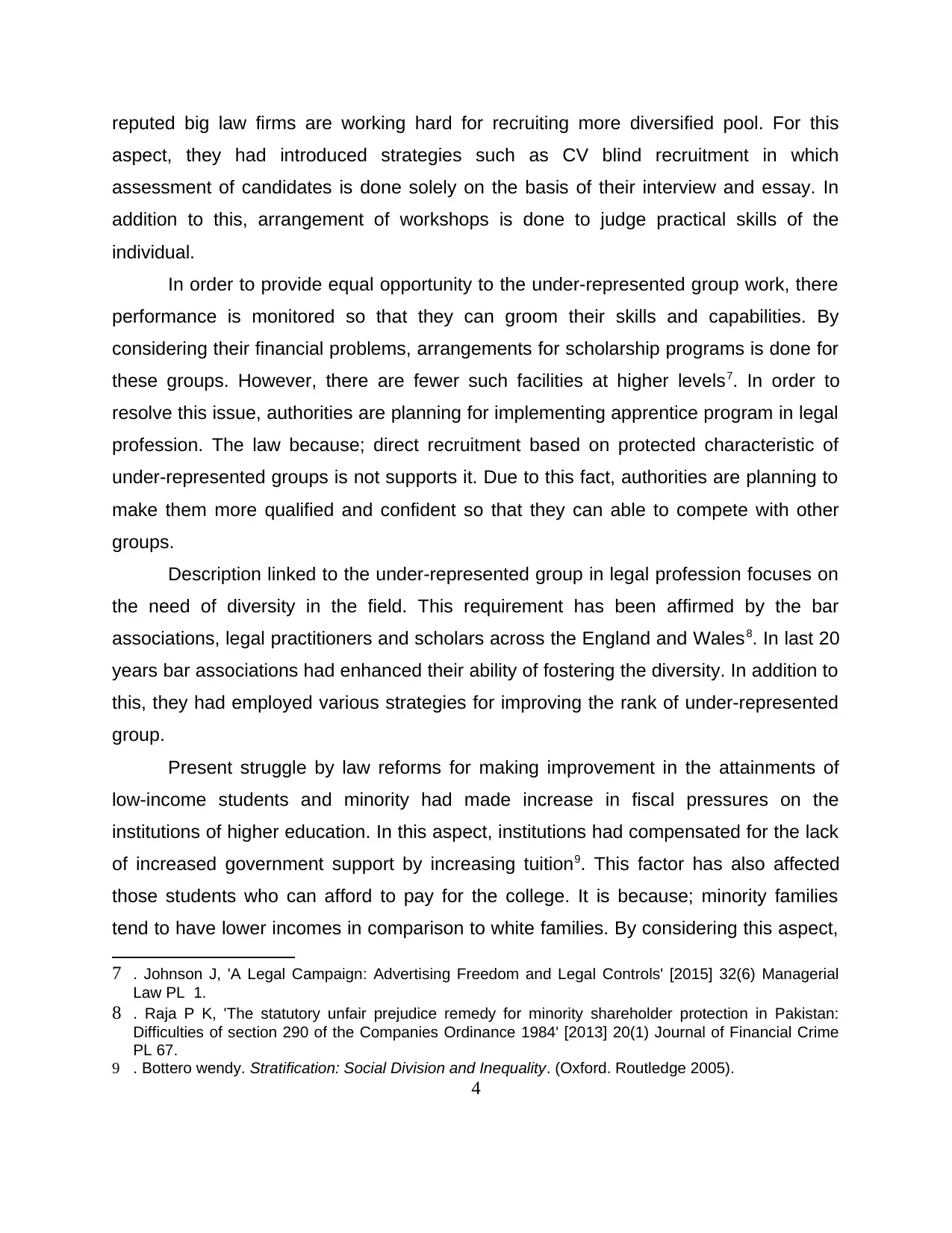
reputed big law firms are working hard for recruiting more diversified pool. For this
aspect, they had introduced strategies such as CV blind recruitment in which
assessment of candidates is done solely on the basis of their interview and essay. In
addition to this, arrangement of workshops is done to judge practical skills of the
individual.
In order to provide equal opportunity to the under-represented group work, there
performance is monitored so that they can groom their skills and capabilities. By
considering their financial problems, arrangements for scholarship programs is done for
these groups. However, there are fewer such facilities at higher levels7. In order to
resolve this issue, authorities are planning for implementing apprentice program in legal
profession. The law because; direct recruitment based on protected characteristic of
under-represented groups is not supports it. Due to this fact, authorities are planning to
make them more qualified and confident so that they can able to compete with other
groups.
Description linked to the under-represented group in legal profession focuses on
the need of diversity in the field. This requirement has been affirmed by the bar
associations, legal practitioners and scholars across the England and Wales8. In last 20
years bar associations had enhanced their ability of fostering the diversity. In addition to
this, they had employed various strategies for improving the rank of under-represented
group.
Present struggle by law reforms for making improvement in the attainments of
low-income students and minority had made increase in fiscal pressures on the
institutions of higher education. In this aspect, institutions had compensated for the lack
of increased government support by increasing tuition9. This factor has also affected
those students who can afford to pay for the college. It is because; minority families
tend to have lower incomes in comparison to white families. By considering this aspect,
7 . Johnson J, 'A Legal Campaign: Advertising Freedom and Legal Controls' [2015] 32(6) Managerial
Law PL 1.
8 . Raja P K, 'The statutory unfair prejudice remedy for minority shareholder protection in Pakistan:
Difficulties of section 290 of the Companies Ordinance 1984' [2013] 20(1) Journal of Financial Crime
PL 67.
9 . Bottero wendy. Stratification: Social Division and Inequality. (Oxford. Routledge 2005).
4
aspect, they had introduced strategies such as CV blind recruitment in which
assessment of candidates is done solely on the basis of their interview and essay. In
addition to this, arrangement of workshops is done to judge practical skills of the
individual.
In order to provide equal opportunity to the under-represented group work, there
performance is monitored so that they can groom their skills and capabilities. By
considering their financial problems, arrangements for scholarship programs is done for
these groups. However, there are fewer such facilities at higher levels7. In order to
resolve this issue, authorities are planning for implementing apprentice program in legal
profession. The law because; direct recruitment based on protected characteristic of
under-represented groups is not supports it. Due to this fact, authorities are planning to
make them more qualified and confident so that they can able to compete with other
groups.
Description linked to the under-represented group in legal profession focuses on
the need of diversity in the field. This requirement has been affirmed by the bar
associations, legal practitioners and scholars across the England and Wales8. In last 20
years bar associations had enhanced their ability of fostering the diversity. In addition to
this, they had employed various strategies for improving the rank of under-represented
group.
Present struggle by law reforms for making improvement in the attainments of
low-income students and minority had made increase in fiscal pressures on the
institutions of higher education. In this aspect, institutions had compensated for the lack
of increased government support by increasing tuition9. This factor has also affected
those students who can afford to pay for the college. It is because; minority families
tend to have lower incomes in comparison to white families. By considering this aspect,
7 . Johnson J, 'A Legal Campaign: Advertising Freedom and Legal Controls' [2015] 32(6) Managerial
Law PL 1.
8 . Raja P K, 'The statutory unfair prejudice remedy for minority shareholder protection in Pakistan:
Difficulties of section 290 of the Companies Ordinance 1984' [2013] 20(1) Journal of Financial Crime
PL 67.
9 . Bottero wendy. Stratification: Social Division and Inequality. (Oxford. Routledge 2005).
4
Paraphrase This Document
Need a fresh take? Get an instant paraphrase of this document with our AI Paraphraser
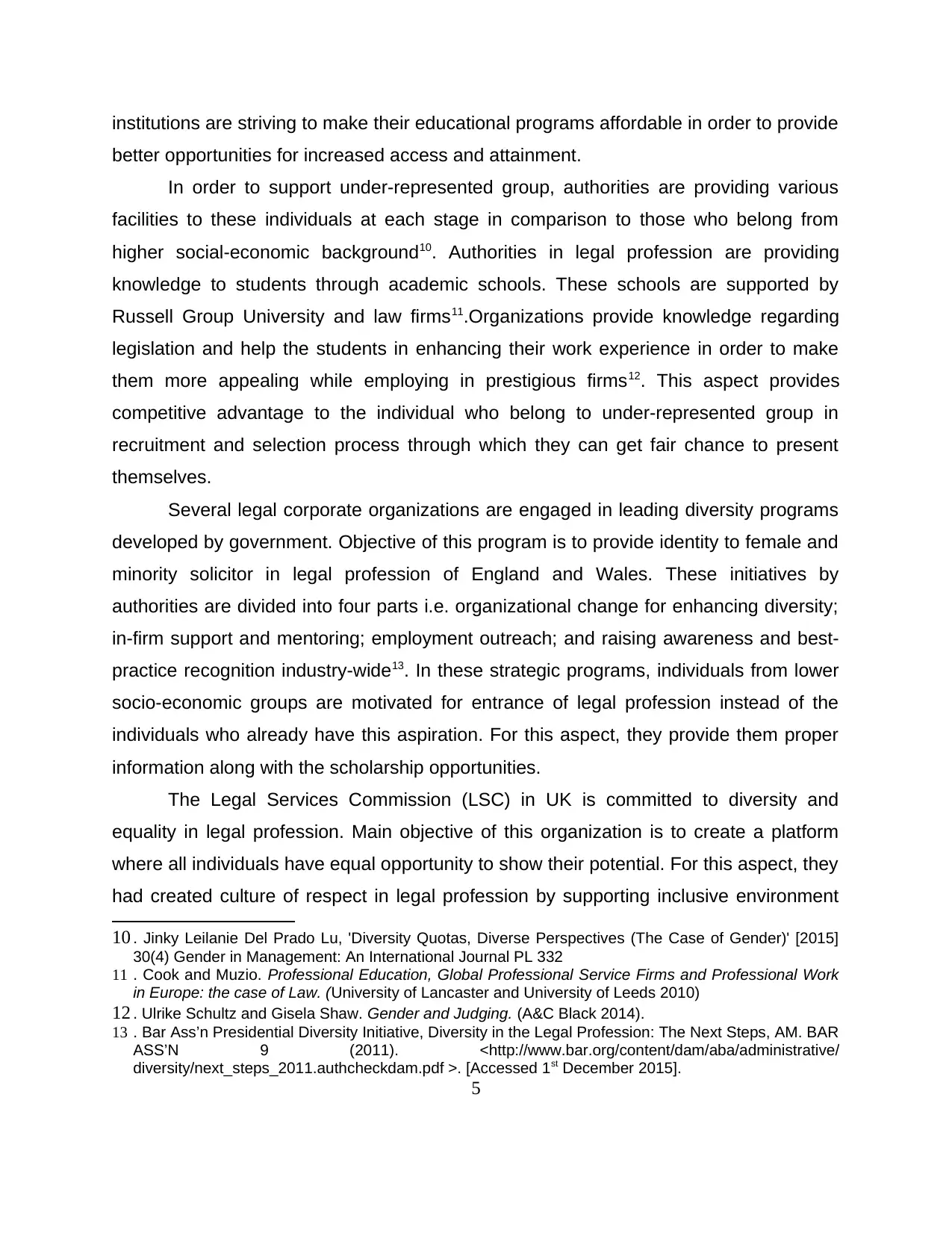
institutions are striving to make their educational programs affordable in order to provide
better opportunities for increased access and attainment.
In order to support under-represented group, authorities are providing various
facilities to these individuals at each stage in comparison to those who belong from
higher social-economic background10. Authorities in legal profession are providing
knowledge to students through academic schools. These schools are supported by
Russell Group University and law firms11.Organizations provide knowledge regarding
legislation and help the students in enhancing their work experience in order to make
them more appealing while employing in prestigious firms12. This aspect provides
competitive advantage to the individual who belong to under-represented group in
recruitment and selection process through which they can get fair chance to present
themselves.
Several legal corporate organizations are engaged in leading diversity programs
developed by government. Objective of this program is to provide identity to female and
minority solicitor in legal profession of England and Wales. These initiatives by
authorities are divided into four parts i.e. organizational change for enhancing diversity;
in-firm support and mentoring; employment outreach; and raising awareness and best-
practice recognition industry-wide13. In these strategic programs, individuals from lower
socio-economic groups are motivated for entrance of legal profession instead of the
individuals who already have this aspiration. For this aspect, they provide them proper
information along with the scholarship opportunities.
The Legal Services Commission (LSC) in UK is committed to diversity and
equality in legal profession. Main objective of this organization is to create a platform
where all individuals have equal opportunity to show their potential. For this aspect, they
had created culture of respect in legal profession by supporting inclusive environment
10 . Jinky Leilanie Del Prado Lu, 'Diversity Quotas, Diverse Perspectives (The Case of Gender)' [2015]
30(4) Gender in Management: An International Journal PL 332
11 . Cook and Muzio. Professional Education, Global Professional Service Firms and Professional Work
in Europe: the case of Law. (University of Lancaster and University of Leeds 2010)
12 . Ulrike Schultz and Gisela Shaw. Gender and Judging. (A&C Black 2014).
13 . Bar Ass’n Presidential Diversity Initiative, Diversity in the Legal Profession: The Next Steps, AM. BAR
ASS’N 9 (2011). <http://www.bar.org/content/dam/aba/administrative/
diversity/next_steps_2011.authcheckdam.pdf >. [Accessed 1st December 2015].
5
better opportunities for increased access and attainment.
In order to support under-represented group, authorities are providing various
facilities to these individuals at each stage in comparison to those who belong from
higher social-economic background10. Authorities in legal profession are providing
knowledge to students through academic schools. These schools are supported by
Russell Group University and law firms11.Organizations provide knowledge regarding
legislation and help the students in enhancing their work experience in order to make
them more appealing while employing in prestigious firms12. This aspect provides
competitive advantage to the individual who belong to under-represented group in
recruitment and selection process through which they can get fair chance to present
themselves.
Several legal corporate organizations are engaged in leading diversity programs
developed by government. Objective of this program is to provide identity to female and
minority solicitor in legal profession of England and Wales. These initiatives by
authorities are divided into four parts i.e. organizational change for enhancing diversity;
in-firm support and mentoring; employment outreach; and raising awareness and best-
practice recognition industry-wide13. In these strategic programs, individuals from lower
socio-economic groups are motivated for entrance of legal profession instead of the
individuals who already have this aspiration. For this aspect, they provide them proper
information along with the scholarship opportunities.
The Legal Services Commission (LSC) in UK is committed to diversity and
equality in legal profession. Main objective of this organization is to create a platform
where all individuals have equal opportunity to show their potential. For this aspect, they
had created culture of respect in legal profession by supporting inclusive environment
10 . Jinky Leilanie Del Prado Lu, 'Diversity Quotas, Diverse Perspectives (The Case of Gender)' [2015]
30(4) Gender in Management: An International Journal PL 332
11 . Cook and Muzio. Professional Education, Global Professional Service Firms and Professional Work
in Europe: the case of Law. (University of Lancaster and University of Leeds 2010)
12 . Ulrike Schultz and Gisela Shaw. Gender and Judging. (A&C Black 2014).
13 . Bar Ass’n Presidential Diversity Initiative, Diversity in the Legal Profession: The Next Steps, AM. BAR
ASS’N 9 (2011). <http://www.bar.org/content/dam/aba/administrative/
diversity/next_steps_2011.authcheckdam.pdf >. [Accessed 1st December 2015].
5
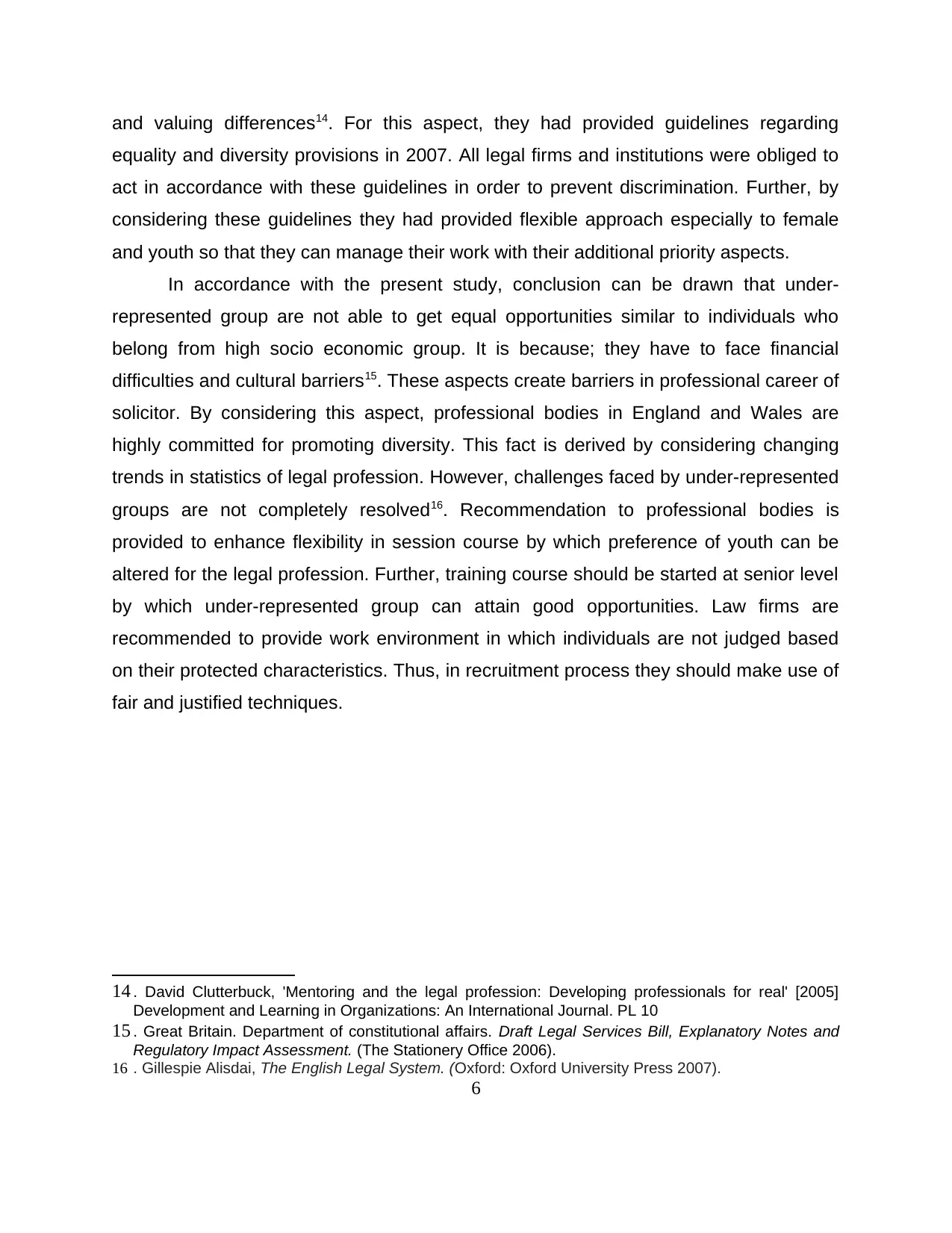
and valuing differences14. For this aspect, they had provided guidelines regarding
equality and diversity provisions in 2007. All legal firms and institutions were obliged to
act in accordance with these guidelines in order to prevent discrimination. Further, by
considering these guidelines they had provided flexible approach especially to female
and youth so that they can manage their work with their additional priority aspects.
In accordance with the present study, conclusion can be drawn that under-
represented group are not able to get equal opportunities similar to individuals who
belong from high socio economic group. It is because; they have to face financial
difficulties and cultural barriers15. These aspects create barriers in professional career of
solicitor. By considering this aspect, professional bodies in England and Wales are
highly committed for promoting diversity. This fact is derived by considering changing
trends in statistics of legal profession. However, challenges faced by under-represented
groups are not completely resolved16. Recommendation to professional bodies is
provided to enhance flexibility in session course by which preference of youth can be
altered for the legal profession. Further, training course should be started at senior level
by which under-represented group can attain good opportunities. Law firms are
recommended to provide work environment in which individuals are not judged based
on their protected characteristics. Thus, in recruitment process they should make use of
fair and justified techniques.
14 . David Clutterbuck, 'Mentoring and the legal profession: Developing professionals for real' [2005]
Development and Learning in Organizations: An International Journal. PL 10
15 . Great Britain. Department of constitutional affairs. Draft Legal Services Bill, Explanatory Notes and
Regulatory Impact Assessment. (The Stationery Office 2006).
16 . Gillespie Alisdai, The English Legal System. (Oxford: Oxford University Press 2007).
6
equality and diversity provisions in 2007. All legal firms and institutions were obliged to
act in accordance with these guidelines in order to prevent discrimination. Further, by
considering these guidelines they had provided flexible approach especially to female
and youth so that they can manage their work with their additional priority aspects.
In accordance with the present study, conclusion can be drawn that under-
represented group are not able to get equal opportunities similar to individuals who
belong from high socio economic group. It is because; they have to face financial
difficulties and cultural barriers15. These aspects create barriers in professional career of
solicitor. By considering this aspect, professional bodies in England and Wales are
highly committed for promoting diversity. This fact is derived by considering changing
trends in statistics of legal profession. However, challenges faced by under-represented
groups are not completely resolved16. Recommendation to professional bodies is
provided to enhance flexibility in session course by which preference of youth can be
altered for the legal profession. Further, training course should be started at senior level
by which under-represented group can attain good opportunities. Law firms are
recommended to provide work environment in which individuals are not judged based
on their protected characteristics. Thus, in recruitment process they should make use of
fair and justified techniques.
14 . David Clutterbuck, 'Mentoring and the legal profession: Developing professionals for real' [2005]
Development and Learning in Organizations: An International Journal. PL 10
15 . Great Britain. Department of constitutional affairs. Draft Legal Services Bill, Explanatory Notes and
Regulatory Impact Assessment. (The Stationery Office 2006).
16 . Gillespie Alisdai, The English Legal System. (Oxford: Oxford University Press 2007).
6
⊘ This is a preview!⊘
Do you want full access?
Subscribe today to unlock all pages.

Trusted by 1+ million students worldwide
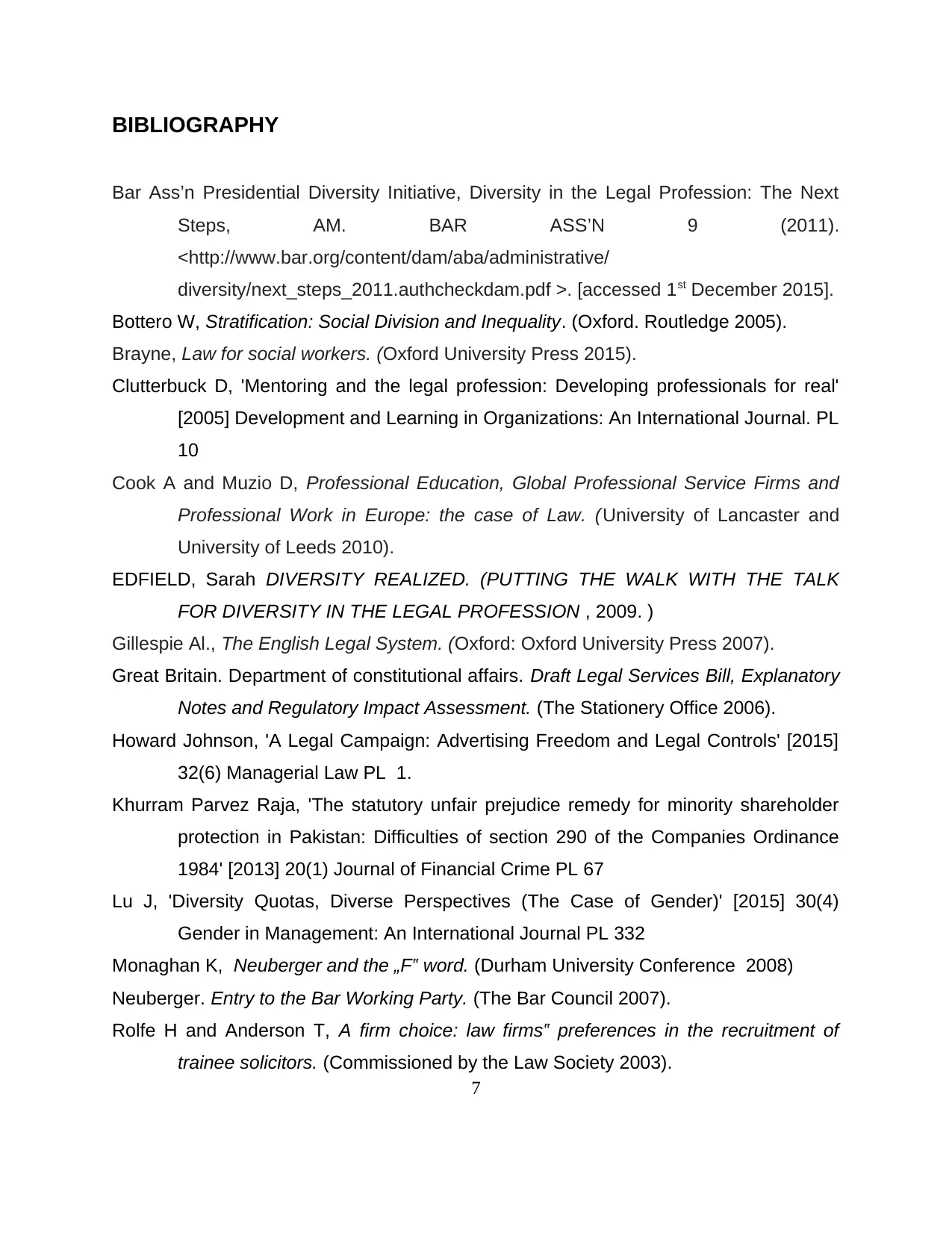
BIBLIOGRAPHY
Bar Ass’n Presidential Diversity Initiative, Diversity in the Legal Profession: The Next
Steps, AM. BAR ASS’N 9 (2011).
<http://www.bar.org/content/dam/aba/administrative/
diversity/next_steps_2011.authcheckdam.pdf >. [accessed 1st December 2015].
Bottero W, Stratification: Social Division and Inequality. (Oxford. Routledge 2005).
Brayne, Law for social workers. (Oxford University Press 2015).
Clutterbuck D, 'Mentoring and the legal profession: Developing professionals for real'
[2005] Development and Learning in Organizations: An International Journal. PL
10
Cook A and Muzio D, Professional Education, Global Professional Service Firms and
Professional Work in Europe: the case of Law. (University of Lancaster and
University of Leeds 2010).
EDFIELD, Sarah DIVERSITY REALIZED. (PUTTING THE WALK WITH THE TALK
FOR DIVERSITY IN THE LEGAL PROFESSION , 2009. )
Gillespie Al., The English Legal System. (Oxford: Oxford University Press 2007).
Great Britain. Department of constitutional affairs. Draft Legal Services Bill, Explanatory
Notes and Regulatory Impact Assessment. (The Stationery Office 2006).
Howard Johnson, 'A Legal Campaign: Advertising Freedom and Legal Controls' [2015]
32(6) Managerial Law PL 1.
Khurram Parvez Raja, 'The statutory unfair prejudice remedy for minority shareholder
protection in Pakistan: Difficulties of section 290 of the Companies Ordinance
1984' [2013] 20(1) Journal of Financial Crime PL 67
Lu J, 'Diversity Quotas, Diverse Perspectives (The Case of Gender)' [2015] 30(4)
Gender in Management: An International Journal PL 332
Monaghan K, Neuberger and the „F‟ word. (Durham University Conference 2008)
Neuberger. Entry to the Bar Working Party. (The Bar Council 2007).
Rolfe H and Anderson T, A firm choice: law firms‟ preferences in the recruitment of
trainee solicitors. (Commissioned by the Law Society 2003).
7
Bar Ass’n Presidential Diversity Initiative, Diversity in the Legal Profession: The Next
Steps, AM. BAR ASS’N 9 (2011).
<http://www.bar.org/content/dam/aba/administrative/
diversity/next_steps_2011.authcheckdam.pdf >. [accessed 1st December 2015].
Bottero W, Stratification: Social Division and Inequality. (Oxford. Routledge 2005).
Brayne, Law for social workers. (Oxford University Press 2015).
Clutterbuck D, 'Mentoring and the legal profession: Developing professionals for real'
[2005] Development and Learning in Organizations: An International Journal. PL
10
Cook A and Muzio D, Professional Education, Global Professional Service Firms and
Professional Work in Europe: the case of Law. (University of Lancaster and
University of Leeds 2010).
EDFIELD, Sarah DIVERSITY REALIZED. (PUTTING THE WALK WITH THE TALK
FOR DIVERSITY IN THE LEGAL PROFESSION , 2009. )
Gillespie Al., The English Legal System. (Oxford: Oxford University Press 2007).
Great Britain. Department of constitutional affairs. Draft Legal Services Bill, Explanatory
Notes and Regulatory Impact Assessment. (The Stationery Office 2006).
Howard Johnson, 'A Legal Campaign: Advertising Freedom and Legal Controls' [2015]
32(6) Managerial Law PL 1.
Khurram Parvez Raja, 'The statutory unfair prejudice remedy for minority shareholder
protection in Pakistan: Difficulties of section 290 of the Companies Ordinance
1984' [2013] 20(1) Journal of Financial Crime PL 67
Lu J, 'Diversity Quotas, Diverse Perspectives (The Case of Gender)' [2015] 30(4)
Gender in Management: An International Journal PL 332
Monaghan K, Neuberger and the „F‟ word. (Durham University Conference 2008)
Neuberger. Entry to the Bar Working Party. (The Bar Council 2007).
Rolfe H and Anderson T, A firm choice: law firms‟ preferences in the recruitment of
trainee solicitors. (Commissioned by the Law Society 2003).
7
Paraphrase This Document
Need a fresh take? Get an instant paraphrase of this document with our AI Paraphraser
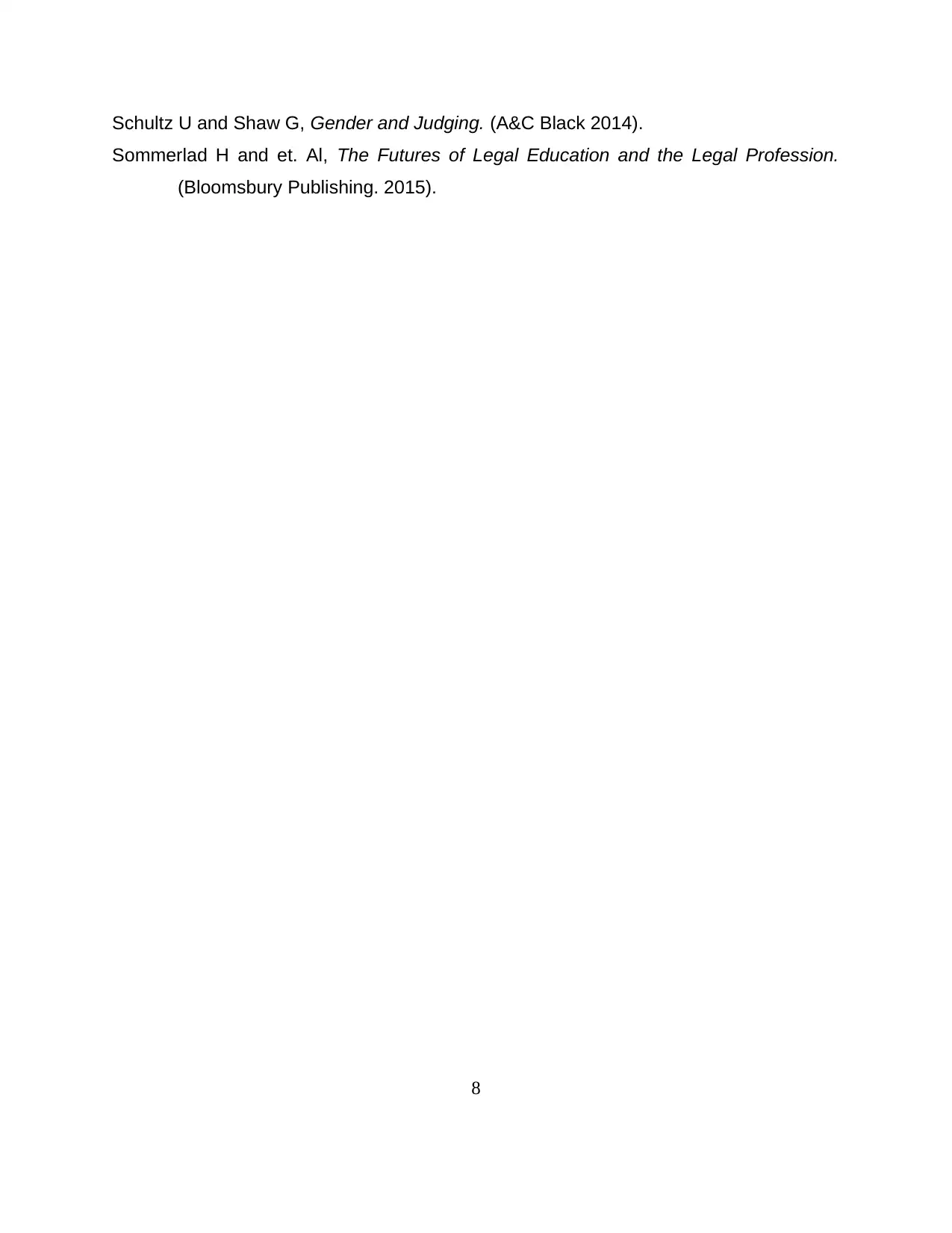
Schultz U and Shaw G, Gender and Judging. (A&C Black 2014).
Sommerlad H and et. Al, The Futures of Legal Education and the Legal Profession.
(Bloomsbury Publishing. 2015).
8
Sommerlad H and et. Al, The Futures of Legal Education and the Legal Profession.
(Bloomsbury Publishing. 2015).
8
1 out of 8
Related Documents
Your All-in-One AI-Powered Toolkit for Academic Success.
+13062052269
info@desklib.com
Available 24*7 on WhatsApp / Email
![[object Object]](/_next/static/media/star-bottom.7253800d.svg)
Unlock your academic potential
Copyright © 2020–2025 A2Z Services. All Rights Reserved. Developed and managed by ZUCOL.





